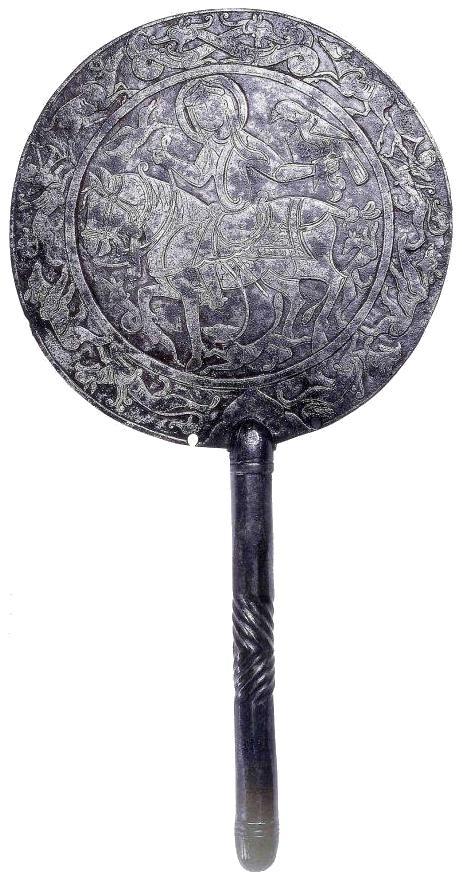
Try Amazon Audible Plus
Seljuq Steel Mirror with Mounted Hunter



Hegira 7th century / AD 13th century, Anatolian Seljuq
Topkapi Palace Museum, Sultanahmet, Turkey
Dimensions: Length 41.5 cm, diameter (of mirror) 21 cm
Museum Inventory Number: 2/1792
Material(s) / Technique(s): Cast steel, low relief and inlay techniques
Provenance: Konya, Turkey
Items of daily use no doubt provide the most important data on social life. This mirror, the only surviving example in steel, provides evidence regarding the social life and iconographic beliefs of the Anatolian Seljuq period.
Source: Museum With No Frontiers
Referenced on p110, God's Warriors, Knights Templar, Saracens and the Battle for Jerusalem by Helen Nicholson & David Nicolle:
The back of a gold-inlaid polished steel mirror from early 13th-century Turkish Anatolia (modern Turkey) decorated with a hunting hawk on his wrist.
282. Mirror with Hunter on Horseback
---------------------------------------
This mirror, with its decorated back - the sole cast-steel object inlaid with gold to survive from thirteenth-century Anatolia combines unique technical features with a widely employed decorative scheme. Its maker is thought to have been trained in one of the Artukid metalworking centers, such as Mardin or Diyabakir, that specialized in casting, although the mirror may have been made elsewhere.1 The central field merges the themes of a hunter on horseback and a dragon-slaying hero. The mounted hunter, with a falcon on one hand and the reins of his horse in the other, has a lively hunting dog tied to his saddle; as he rides, a duck flies away and a fox(?) seeks cover.
Fragments of tile decoration from the Seljuk palace in Konya offer close parallels to the pose and costume of this falconer.2 Although he appears nonchalant, hints are given of the rider's special powers, such as the benediction inscribed in minute letters on his horse's harness. The horse is about to trample a coiled serpent underfoot, and a pair of coiled, crossed serpents above the hunter's head recalls the use of carved serpents as guardians at the gate.3 The mirror's decoration may reflect the long-standing Anatolian belief in the power of a demon-slaying hero to offer protection against the evil eye.4
1. Erginsoy 1978, pp. 449-62, figs. 225a,b; Tapan 1983, p1. D. 128.
2. Yetkin 1972, p. 160, pl. III.
3. Burckhardt 1976, p. 113, pl 95s; Öney 1988, figs. 31, 32.
4. Russell 1995, pp. 40-41; Vikan 1983, pp. 79-80.
LITERATURE Washington, D.C., 1966, no. 168, pp. 97-98; Öney 1969, p. 171, fig. 21; Aslanapa 1971, p288, fig. 222; Inal 1971, p. 171, fig. 7; Esin 1976, p. 450, fig. II; Erginsoy 1978, pp. 456-62, figs. 225a,b; Erginsoy 1980, pl 153; Tapan 1983, pl. D. 128.
EXHIBITIONS: Washington, D.C., 1966, n0. 168, pp. 97-98; Istanbul 1983, pl. D. 128.
Source: p424 The glory of Byzantium : art and culture of the Middle Byzantine era, A.D. 843-1261 / edited by Helen C. Evans and William D. Wixom
The Metropolitan Museum of Art, NY